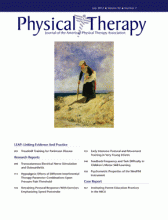Abstract
Background Transcutaneous electrical nerve stimulation (TENS) is commonly used for the management of pain; however, its effects on several pain and function measures are unclear.
Objective The purpose of this study was to determine the effects of high-frequency TENS (HF-TENS) and low-frequency TENS (LF-TENS) on several outcome measures (pain at rest, movement-evoked pain, and pain sensitivity) in people with knee osteoarthritis.
Design The study was a double-blind, randomized clinical trial.
Setting The setting was a tertiary care center.
Participants Seventy-five participants with knee osteoarthritis (29 men and 46 women; 31–94 years of age) were assessed.
Intervention Participants were randomly assigned to receive HF-TENS (100 Hz) (n=25), LF-TENS (4 Hz) (n=25), or placebo TENS (n=25) (pulse duration=100 microseconds; intensity=10% below motor threshold).
Measurements The following measures were assessed before and after a single TENS treatment: cutaneous mechanical pain threshold, pressure pain threshold (PPT), heat pain threshold, heat temporal summation, Timed “Up & Go” Test (TUG), and pain intensity at rest and during the TUG. A linear mixed-model analysis of variance was used to compare differences before and after TENS and among groups (HF-TENS, LF-TENS, and placebo TENS).
Results Compared with placebo TENS, HF-TENS and LF-TENS increased PPT at the knee; HF-TENS also increased PPT over the tibialis anterior muscle. There was no effect on the cutaneous mechanical pain threshold, heat pain threshold, or heat temporal summation. Pain at rest and during the TUG was significantly reduced by HF-TENS, LF-TENS, and placebo TENS.
Limitations This study tested only a single TENS treatment.
Conclusions Both HF-TENS and LF-TENS increased PPT in people with knee osteoarthritis; placebo TENS had no significant effect on PPT. Cutaneous pain measures were unaffected by TENS. Subjective pain ratings at rest and during movement were similarly reduced by active TENS and placebo TENS, suggesting a strong placebo component of the effect of TENS.
Footnotes
Dr Rakel, Dr Walsh, and Dr Sluka provided concept/idea/research design. Ms Vance, Dr Rakel, Ms Blodgett, Dr Walsh, and Dr Sluka provided writing. Ms Vance, Dr Rakel, Ms Blodgett, Dr DeSantana, and Dr Sluka provided data collection. Ms Vance, Dr Rakel, Dr Amendola, and Dr Sluka provided data analysis. Ms Vance, Dr Rakel, and Ms Blodgett provided project management. Dr Rakel and Dr Sluka provided fund procurement and facilities/equipment. Dr Amendola provided study participants. Ms Vance, Dr Rakel, and Ms Blodgett provided clerical support. Ms Vance, Dr Rakel, Ms Blodgett, Dr DeSantana, Dr Amendola, Dr Walsh and Dr Sluka provided consultation (including review of manuscript before submission).
The authors thank Shannon Lehman, who served as the TENS effectiveness coordinator, for assistance with the study. The TENS units and supplies used in the study were donated by DJO Inc.
This study was approved by the Human Subjects Institutional Review Board at The University of Iowa.
This study was supported by the National Institutes of Health (R03-NR010405), a Marsha and Ralph Congdon Faculty Development Fellowship in Acute Care for the Chronically Ill, and The University of Iowa Carver College of Medicine.
This trial is registered at ClinTrials.gov: NCT01354054.
- Received June 1, 2011.
- Accepted March 22, 2012.












